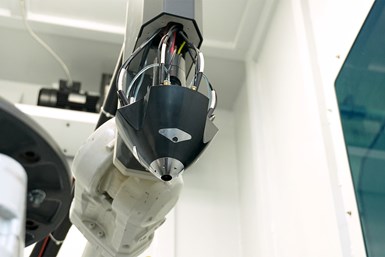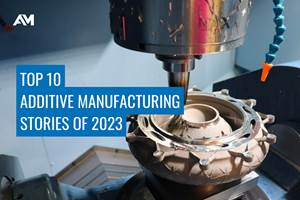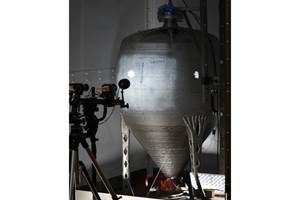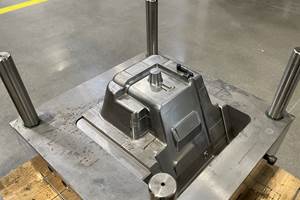Fastech Joins Meltio’s US Manufacturing Partner Network
Fastech has incorporated Meltio’s wire-laser metal 3D printing technology into its portfolio with the acquisition of a Meltio Engine Robot Integration.
The Meltio Engine Robot Integration enbles Fastech to print metals in an environment using a 6-axis robotic system. Source: Meltio
Fastech Inc. has joined Meltio’s manufacturing partner network in the U.S. Based in Virginia, Fastech is a manufacturing solutions provider with WAAM (wire arc additive manufacturing), CNC and reverse engineering capabilities, providing an end-to-end solution to the industry. Based in Spain, Meltio is a laser metal deposition technology manufacturer.
The new alliance strengthens Meltio’s presence in the U.S. Meltio says this agreement is another step forward in its commitment to be a reliable and firm ally of all industries to revolutionize their manufacturing and repair processes of metal parts with materials such as stainless steels, nickel and titanium, among others.
Fastech is an additive and subtractive manufacturing services company that applies WAAM, CNC and reverse engineering techniques to provide an end-to-end manufacturing solution for a variety of industries. After verifying the advantages of Meltio’s unique wire-laser metal 3D printing technology, Fastech incorporated the technology into its portfolio by acquiring a Meltio Engine Robot Integration.
“We at Fastech are excited to start this great partnership with Meltio to continue our growth trajectory. This partnership will enhance our capabilities to provide an end-to-end solution for our customers,” says Alan Pearce, Fastech CEO. “The Meltio Engine Robot Integration will allow us to print metals in an environment using a 6-axis robotic system. This grants us to manufacture very large titanium components, as well as other reactive alloys within this homogeneous environment, assuring the utmost level of quality every day.”
The ability to undertake a build volume for components up to 6 ft3 using wire and laser can be beneficial in manufacturing thin, more detailed features seamlessly while maintaining excellent mechanical properties. “Furthermore, our postprocessing 5-axis machining services, full-component 3D dimensional inspection, as well as offering nondestructive and destructive inspection of test specimens, closes the gap to complete our customers’ DED needs with our end-to-end service,” Pearce adds.
The Meltio Engine Robot Integration is well suited for large and complex 3D printing, repair, cladding and feature additions. It also enables the creation of highly complex parts with machining tolerances in the same process.
According to Meltio, its multimetal 3D printing technology precisely stacks weld beads on top of one another when introduced into a laser-generated melt pool. The process uses commodity welding wire, which the company says is the cleanest, safest and lowest cost metal feedstock on the market. The Meltio Engine seamlessly integrates with both robotic as well as CNC equipment, bringing new metal additive manufacturing capabilities to a wide range of industries and applications.
According to Meltio, Fastech will play a crucial role in Meltio’s manufacturing network by supporting a growing demand for wire-laser metal 3D printed parts from the North American market. It’s a demand that comes from a variety of markets, including defense, heavy machinery, energy, oil and gas, and automotive and aerospace sectors.
Meltio also says this partnership is an example of how the company’s partners can develop third-party solutions to meet industry needs and contribute to the development of its technology and application development alongside end users.
Related Content
Top 10 Additive Manufacturing Stories of 2023
Laser powder bed fusion, proprietary AM processes, machining and more made our list of top 10 articles and videos by pageviews this year.
Read MoreArmy Corps of Engineers 3D Prints New Poe Lock Arrestor Arm
New Poe Lock arrestor arm is the largest U.S. civil works component produced by a 3D printer. A six-month Poe Lock closure would temporarily reduce the U.S. gross domestic product by $1.1 trillion, resulting in the loss of 11 million jobs, according to a DHS study. Faced with this challenge, advances in additive manufacturing offered transformative potential.
Read MoreFinland’s Largest Metal 3D Print Withstands Pressure Vessel Test, Vastly Exceeding Expectations
The pressure vessel was created in cooperation between Andritz Savonlinna Works and the Finish Additive Manufacturing Ecosystem (FAME), and withstood the nondestructive and destructive tests carried out by LUT University.
Read MoreDaimler, OMIC Evaluate Wire-Fed DED for Moldmaking
3D printing a core and cavity on machine from Gefertec, followed by machining, allowed for a complete mold tool to be produced in three days.
Read MoreRead Next
Alquist 3D Looks Toward a Carbon-Sequestering Future with 3D Printed Infrastructure
The Colorado startup aims to reduce the carbon footprint of new buildings, homes and city infrastructure with robotic 3D printing and a specialized geopolymer material.
Read MorePostprocessing Steps and Costs for Metal 3D Printing
When your metal part is done 3D printing, you just pull it out of the machine and start using it, right? Not exactly.
Read MoreProfilometry-Based Indentation Plastometry (PIP) as an Alternative to Standard Tensile Testing
UK-based Plastometrex offers a benchtop testing device utilizing PIP to quickly and easily analyze the yield strength, tensile strength and uniform elongation of samples and even printed parts. The solution is particularly useful for additive manufacturing.
Read More





















